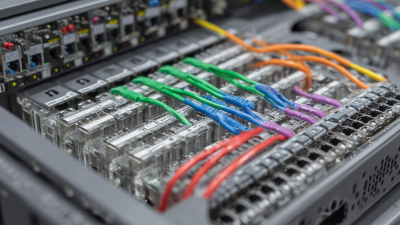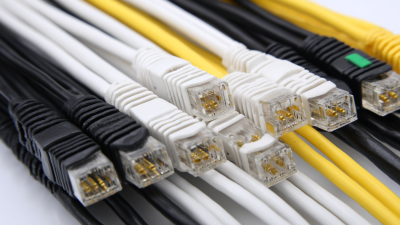Unlocking the Power of LC Patch Panels: A Comprehensive Guide for Network Optimization
In today's fast-paced networking environment, the efficiency of infrastructure is paramount, and this is where the LC patch panel comes into play. A recent report by ResearchAndMarkets indicates that the global patch panel market is expected to reach $4.2 billion by 2025, with increased demand for high-density solutions like LC patch panels driving this growth. Designed to optimize fiber optic networks, LC patch panels facilitate quick connections and provide superior signal quality, crucial for data centers and enterprise networks striving for maximum performance. By employing these innovative solutions, organizations can significantly reduce network congestion and improve overall system reliability, making them a vital component in modern network optimization strategies.

Understanding LC Patch Panels: Key Features and Benefits
LC patch panels are essential components in modern network management, offering a compact and efficient way to manage fiber optic connections. One of the key features of LC patch panels is their high density, allowing numerous connections in a limited space, which is crucial for data centers and large organizations. The design also facilitates easy organization and labeling, enabling network administrators to quickly identify and troubleshoot connections.
**Tips**: When choosing an LC patch panel, consider the number of ports you'll need based on current and future network demands. Additionally, ensure compatibility with existing hardware to optimize performance.
Another significant benefit of LC patch panels is their ability to minimize signal loss and maintain high-quality connectivity. Their hinged design simplifies the installation and maintenance process, reducing downtime during upgrades or repairs. Furthermore, LC connectors generally feature a push-pull mechanism that enhances ease of use and reliability.
**Tips**: Regularly inspect connectors for dust or damage to maintain optimal performance. Implementing a structured cabling system with LC patch panels can lead to improved data transmission rates and reliability across your network.
Unlocking the Power of LC Patch Panels: A Comprehensive Guide for Network Optimization
| Feature | Description | Benefits |
|---|---|---|
| High Density | Optimizes space in data centers | Allows more connections in less space |
| Modularity | Interchangeable modules for flexibility | Easier upgrades and customized setups |
| Ease of Installation | Quick and straightforward installation process | Saves time and reduces labor costs |
| Improved Cable Management | Organizes and routes cables efficiently | Enhances airflow and reduces clutter |
| High Performance | Supports high-speed data transmission | Ensures optimal network performance |
| Cost-Effective | Reduces overall network costs | Low maintenance and durable solution |
Essential Tools for Installing and Managing LC Patch Panels
LC patch panels are essential components in network management, providing a means to organize and optimize connections within a telecommunications system. To effectively install and manage LC patch panels, several essential tools come into play. For instance, a fiber optic cleaver is crucial for ensuring precision when preparing fiber ends for termination, while a fusion splicer guarantees a reliable and low-loss connection between fibers. Additionally, a quality multi-meter can help technicians test connectivity and performance, ensuring that the network operates at peak efficiency.
According to industry reports, the global market for fiber optic equipment, including patch panels, is expected to grow significantly, driven by the increasing adoption of high-speed internet services and the proliferation of smart devices. Specifically, it has been noted that demand for structured cabling systems is projected to increase at a CAGR of 12% through 2025, highlighting the importance of investing in the right tools for effective network management. Furthermore, advancements in technology mean that the modern installer must be well-versed in handling these tools, as proficiency directly correlates with the quality and reliability of network setups. The right equipment not only improves efficiency but also enhances overall network performance, making it imperative for professionals to stay updated on best practices and industry standards.
Network Optimization Through LC Patch Panels
This chart illustrates the importance of various factors in optimizing network performance using LC patch panels. The data represents the percentage impact of each factor on overall network efficiency.
Best Practices for LC Patch Panel Configuration and Optimization
When configuring LC patch panels, it's essential to follow best practices that ensure optimal performance and ease of maintenance. First, proper labeling of ports is crucial. Each port should have a clear and consistent naming convention that allows for quick identification. This practice reduces confusion and streamlines troubleshooting processes, ensuring that network administrators can efficiently manage their setups.
Moreover, organizing cables effectively can significantly enhance network performance. Utilizing cable management accessories such as Velcro ties or cable trays prevents tangled cables and maintains airflow, which is vital for cooling equipment. Additionally, ensuring that the fibers are routed in an orderly fashion helps in minimizing stress on the cables, thus prolonging their lifespan and maintaining signal integrity. Regularly reviewing and updating the configuration based on network changes also plays a vital role in optimizing the use of LC patch panels, allowing for scalability and adaptability in evolving network environments.
Troubleshooting Common Issues with LC Patch Panels
When working with LC patch panels, various issues may arise that can hinder network performance. One common problem is poor connectivity, often caused by dirt or dust on the connections. It's vital to ensure that all connectors are clean and free from contaminants. Regularly using fiber optic cleaning kits can prevent these issues and maintain optimal performance.

Another issue frequently encountered is incorrect patching, where cables are misrouted or plugged into the wrong ports. This can lead to confusion and downtime during troubleshooting. To avoid this, label all cables and ports clearly, and maintain a patching documentation log. This way, any changes made to the network can be tracked and understood by everyone involved.
Tips: Always conduct regular visual inspections of your LC patch panels to check for physical wear or signs of damage. Additionally, consider implementing a structured cabling management system to keep everything organized and facilitate easier troubleshooting in the future. Lastly, pay attention to temperature regulation in the networking environment, as overheating can affect fiber performance and longevity.
Future Trends in LC Patch Panel Technology and Applications
The future of LC patch panel technology is poised for significant advancements as the global market continues to expand. With a projected growth from $1.28 billion in 2024 to $2.78 billion by 2032, the industry is witnessing a compound annual growth rate (CAGR) of 10.44%. This surge can be attributed to the increasing demand for efficient network infrastructure solutions. The rise of structured cabling systems, expected to reach USD 20.38 billion by 2030, further emphasizes the necessity for effective patch panel implementations.
Emerging trends within the LC patch panel technology are focused on enhanced modularity and connectivity, which cater to the growing complexity of data networks. Innovations such as the integration of 3D printing technology for customized patch panels pave the way for lightweight, efficient designs tailored to specific applications. Additionally, as the need for robust network performance continues to rise, future applications will likely involve higher density configurations and improved cable management solutions, ensuring optimized network reliability and efficiency in the face of evolving technological demands.

Related Posts
-

5 Best LC Patch Panels for Optimal Network Performance in 2023
-

What is a Fiber Optic Patch Cord and How Does It Improve Connectivity
-

7 Best Patch Cable Options for Seamless Connectivity Solutions in 2023
-

How to Choose the Right Patch Panel for Your Networking Needs
-

Innovative Solutions for Enhancing Network Performance with Quality Patch Cables
-

How to Choose the Right Cat 6 Bulk Cable for Your Network Needs
